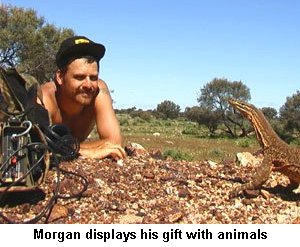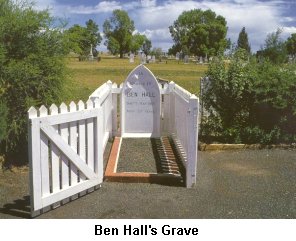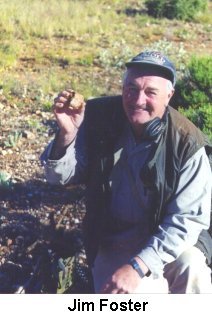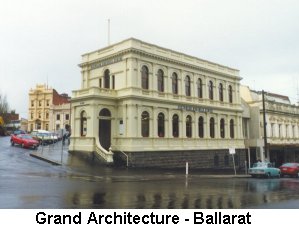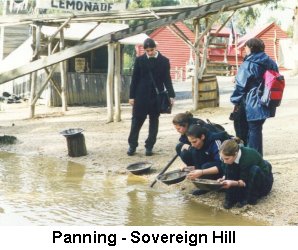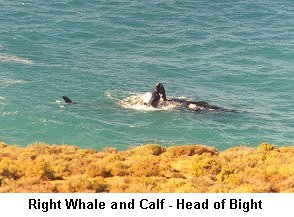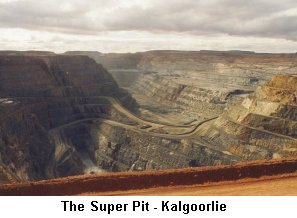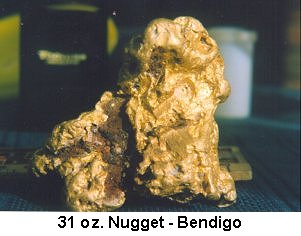
| August 2000 | ||||||||||||||||
|
||||||||||||||||
Contents
|
||||||||||||||||
| 1. EDITORIAL The recent debate regarding the possible closures of Victoria's great forests has created considerable concern throughout the gold regions of Victoria. None more so that the smaller communites that rely heavily on fossickers, who provide substantial financial support to these struggling communities. It now seems that the outstanding response from public meetings and other representations to government and opposition members of Parliament, may be having some effect. Previous experience where these forests have come under management have led to a denial of access in many previously accessible areas - thus denying the owners of these forests reasonable access. The Government does not own these forests - the people do. Reasonable preservation of these areas by government is expected. Closures, such as those recommended are unnecessary and will decimate the fragile communities that rely heavily on visitors who financially support them.
NOTE: The previous notification of the appointment of Clay "Silver" Currence as the representative of Gold Net Australia Online in the United States and Canada was rescinded on 1 August 2000. REPRESENTATIVES WANTED: Gold Net Australia Online is seeking agents with displayed honesty and integrity to represent Gold Net in other countries. Part of the duties will include promoting gold tours and sales of gold products. e.g. nuggets and nugget jewellery. For further details: Email the Editor at: [email protected]
GEAR FOR SALE: We have recently commenced this section. If you have gear for sale - that relates to detecting, sluicing and associated products - we will list them for a commission - so there is no up front cost for you. Arrangement by private treaty. EMAILS: We are still having some difficulties returning Emails. Some are returned from the mail Daemon - so if your name is Robert, in the UK - Pete, in Alaska - and John in Australia. Please check your email addresses and try again so we can reply. COMING SOON: We are presently negotiating to provide some good quality products at low prices. e.g. GPS Systems - and Digital Scales - Keep a look out for these - SOON.
Email: [email protected] All material in this magazine is copyright and may not be reproduced in any part or form whatsoever without written permission from the publisher.
|
||||||||||||||||
|
2. IT COULDN'T HAVE GONE TWO NICER GUYS by Les Lowe I first met the two Swedish tourists in Leonora Caravan Park as planned. What a sight they were. Two young guys about 35 years old but "white as sheets", the pair of 'em. I quickly discovered that they had just flown 36 hours from a Swedish winter of minus 15C to a West Australian early autumn of 25C and torrential tropical rain. The West Australian Goldfields were soaking wet and they loved "this beautiful weather". We hit the road for the bush as it began to pour down with rain. The locals reckoned we were crazy going out there. But in my opinion there is only one place to be in the Goldfields when it rains and that place is in the bush. If it rains heavily when you're in town then you're stuck in town. But if you're in the bush when it rains, then at least you can walk around detecting when the rain stops. Plus it was my job to get them out there before it became too bad to travel. Our first stop was what most would consider a "beat out" area -Murrin Murrin. A lot of folks come away from here finding nothing. They all seem to go to the same old well known patches that are in all the guide books. Murrin is a huge area and a lot of it has still not been detected. I can always find something there. Gunnar and Morgan, the two Swedes, were just awestruck by the old mines, the dryblowing areas, huge quartz blows and the beauty and "remoteness" of the place. They were also "awestruck" by the mud holes and 4 wheel driving that they had to do. An experience in itself if you're not accustomed to it. After a few "spills and thrills" we arrived at my lease in the Murrin area and set up camp. Ample firewood and a good drop of diesel soon had a good fire going and the "billy" was boiling for a "cuppa" . It was a bit too late to get out detecting but they were keen so they had an hour wandering around the camp. The following day we set out for a full days detecting, hopefully we'd get the first pieces of nugget gold for these guys. The area was "just to one side" of a well known "guidebook area". I had found gold there quite often and it had never been "gridded" as the ground is too hard to show a chainmark. It was a good place to start - not TOO easy to find gold and very open so they wouldn't get lost! Both Gunnar and Morgan had done some gold dredging in California but wanted to try detecting in Western Australia "for a chance at some real gold". They were both new to metal detecting and that was very apparent when I observed their "style". With a Pulse Induction detector such as the Minelab SD series it is essential to "SLOW DOWN". The silicon chip technology of these machines dictates a much slower sweep speed than the old VLF machines of yester year. Gunnar and Morgan were going through the bush like two brushcutters.
Off to another spot,again "just off the guide-book track",my two European charges began their day moving at a snails pace and really listening for those faint, deep signals. About an hour went by and sure enough, impatience set in and they were off again like two hares. Isn't it strange that the less gold you find, the quicker you swing. Gunnar at last stumbled over a nice 4 gram piece and then another shortly afterwards. I wandered over for a chat and to have a look at his "first Australian Nugget". I advised him to stay in that immediate area and keep working around the two pieces. I really enjoy it when folks that are with me find some gold. I reckon I'm happier than they are. Perhaps it's the confirmation of my own ability as a prospector, perhaps I just like people, perhaps I know that if they don't find it then I probably won't find that particular piece either. There's a whole load of Western Australia that hasn't yet been thoroughly picked over and I realise that I couldn't cover all of that in ten lifetimes. So why be greedy when a "new chum" finds HIS nugget; enjoy the moment with him I say. There's plenty of ground left for me to have a look at and plenty of time to do it. These guys were having the "holiday experience of a lifetime" so I took every opportunity to ensure that they enjoyed it. Meanwhile, as a "pro-prospector" I had the rest of my life to have look for nuggets. Gunnar and Morgan had to return to regular jobs in Sweden in a few weeks time. My job was making sure that they enjoyed their time in W.A. So, back to "The Adventures of Gunnar and Morgan". Gunnar wandered away from his "two piece patch" after half an hour. I wandered into it at the same time. Sure enough I picked up another nugget within 5 minutes of where Gunnar had stopped and wandered off. I'd given then both the opportunity to 'clean it out' but now it was my turn to pick up the leftovers. I watched Gunnar from afar as went ever closer to the nearby fenceline. Eventually, he reached a point where I began to think "Hmmm, that fence is going to play havoc with that detector if he takes one more step". I carried on trying to get another piece from what was now a "three piece patch" when I was startled by a tap on the shoulder. Gunnar stood there with a pained expression on his face saying, "Les, I need some help over here, have you got a minute, please".
He looked in the small handful and there it was - all 3.5 ounces of beautiful gold nugget. Well, I don't know who had the biggest grin - me or Gunnar. He just sat there for 5 minutes - speechless and grinning like the proverbial cat. "That was some edge effect, eh, Gunnar". He still couldn't talk properly. Just sort of smiled at me. After that, every day in Western Australia was paradise for Gunnar and Morgan - gold or no gold. They were content making campfires, eating a never ending supply of sausages and just walking around photographing kangaroos, emus and lizards - particularly Morgan. He had a gift with animals that was uncanny. He'd walk for miles just to spend hours studying a kangaroo or lizard. It worried me a bit when he tried to study a 4 foot Mulga Snake at REAL close quarters though. But that Morgan is a character that I'll tell of in another tale from the "Adventures of Gunnar and Morgan" - two great guys from Sweden who I'd welcome back here anytime. Thanks to you both for your friendship, coversation, ability and above all to Morgan - I don't what planet you came from mate, but it wasn't this one here!
|
||||||||||||||||
|
||||||||||||||||
|
3. BEN HALL - BUSHRANGER - PART 7 by Craig Wilson The final chapter of the Hall gang began on Friday the 17th March when early in the morning the three felons help up the residents of Wallendbeen station, where they questioned the occupants about the numbers of police in the area. Later that day they robbed a group of Chinese diggers. Gilbert firing into the crown seriously wounding one of them in the thigh.
At dawn the next day a group of mounted troopers located the bushrangers in an outstation hut on Wallandbeen station while they were yarding some horses. Dunn was mounted while Hall and Gilbert were on foot. All bolted into the bush with the police in pursuit. A fierce gun battle ensued, with the bushrangers withdrawing as the troopers advanced.
Leaving Gilbert in a shepherd's hut Hall and Dunn walked to Beggan Beggan station and held up the 16 employees. Here they stole three horses, saddles and bridles and supped before returning to collect Gilbert.
At this time the police received a major boost with the arrival of better arms that placed them on an even footing with the best armed bushranger.
On Saturday March 25th the Hall gang rode into Forbes and robbed a store of 81 pounds in notes.
Later, on April 24th Sub-Inspector Norton, Sergeant Armstrong, Trooper McArthur and three blacktrackers were seen camped near Marengo. On April 29th the three felons made their last hold up together. They approached Yamma station near Forbes, intending to plunder the station. Some food and drink were taken and consumed. They later left the homestead, taking with them a valuable racehorse, along with two other horses. It was at this time that the gang separated, intending to rejoin later. Sub-Inspector Davidson had received information that the gang was in the area and had moved his men into dense scrub near Billabong Creek, and awaited for a police informant to contact him.
That evening the police moved into position around the informer's hut and at about 10pm watched a dark figure come from the hut and move his two horses, after which he lay down in the scrub to sleep for the night. At about half past six in the morning the troopers saw the figure, bridle in hand walking towards his horses. He was about 100 yards away, and the police silently began to run after him in stockinged feet. They were about 50 yards away when Hall realised he was not alone. Hall began to run with Davison in pursuit - and called on him to surrender on several occasions. Hall refused and kept running. Davidson stopped and aiming his double barrel shotgun fired at the fleeing felon, hitting Hall squarely in the back. Two other police also fired using shotguns - both hitting their mark. Hall slumped towards a group of saplings, and turning towards the police Hall appeared to be raising a pistol when he was struck with a shot from a Colt revolving carbine which struck him squarely, breaking his pistol belt and passing right through his body.
Hall now held himself up and shouted, "I am wounded - shoot me dead." The body was strung over one of Hall's stolen horses and with three troopers Sub-Inspector Davidson rode in triumph into Forbes. Ben Hall was buried on Sunday 7th May with about 50 mourners and 100 interested onlookers present. So ended the life of Ben Hall.
Hall's cohorts, John Gilbert and John Dunn were disillusioned after the death of Hall. They were both been proclaimed outlaws on May 10th and could now be shot on site by anyone. Senior Constable Hales organised a party of police to attend the hut and in pouring rain. As two of the police officers approached the hut and entered shots were fired at them. They returned fire and withdrew. The two bandits attempted to escape through a back window and the police opened fire on the fleeing felons. During the initial engagement, Constable King was wounded in the foot as was Dunn, in the arm. Reaching a creek, Gilbert turned and fired his rifle at the police, and then turned and began to run down the creek. Constable Bright aimed and fired at Gilbert, hitting him directly in the body, the round hitting him in the heart, the outlaw falling dead. Pursuit of Dunn continued, but he escaped into the dense bush.
Dunn recovered from his wound following surgery, and was conveyed to Sydney where he stood trial for the murder of Constable Nelson at Collector. So ends the great saga of perhaps the most notorious bushranger in Australian colonial history, Bell Hall.
|
||||||||||||||||
|
||||||||||||||||
|
4. PROFILE - JIM FOSTER by Brad Williams Jim Foster became interested in detecting for gold and coins in early 1979, and in September 1979 he purchased a Garrett Deepseeker, and headed for the Golden Triangle district of Victoria. Being married with three small children meant he could only get away to the goldfields on weekends. It took three weekends of detecting before he found his first gold nugget. It was at Hard Hill, near Dunolly, Victoria in November 1979 and Jim can still remember the thrill of finding gold. It was a small nugget, flat and smooth weighing only two grams but to this day he still has it. The other three nuggets he found later that day have long gone. In May 1980, tired of detecting alone, he instigated a public meeting, which resulted in the forming of the South Eastern Detector club. This club has continued until this day, over twenty years later and has given a great deal of pleasure to scores of members over the years. It has also contributed greatly to detecting both for gold and coins in Australia.
In 1984 Jim began a four-year outside TAFE College course on writing, for the media. This course had a profound affect on his life, and his detecting. By the time he was half way through the course he was writing as a freelance for the local paper, the Australian Gem & Treasure magazine, Caravan World magazine and a couple of U.S. mags as well. Most of his writing was on detecting, caravanning, and allied outdoor activities. He soon became known Australia Wide as an authority on metal detecting, for both gold and coins. In 1990 he was able to make my first trip to the outback country detecting for gold. Tibooburra, in far north west New South Wales was his first choice. Leading a party of seven in five vehicles for nine days through desert country, that was so starkly and dramatically beautiful that he was totally hooked. This prompted a return to the Outback every year for the next five years to find gold and enjoy the beauty of the desert. Over the years Jim used many makes and models of detectors, often field testing new models for different companies. Beginning with the Garret Deepseeker he kept that machine and used it for both gold and coins for seven years. Adding a Goldseeker 15000 (the first Minelab detector) to my armoury. This detector was so good that he later bought a Minelab Dual Ace and sold the Deepseeker. After the Dual Ace came the wonderful Minelab XT17000 which found him more gold than he had ever found before.
Since around 1984 Jim had been accompanied in the field by his delightful wife Cheryl. In late 1992 Cheryl began using the Minelab Eldorado and increased her gold finds as well. Cheryl used the Eldorado until the incredible SD2000 burst onto the detecting world. Jim bought one of those and Cheryl then used the XT17000.
Jim and Cheryl both use Minelab SD2200 detectors with Coiltek 14" double D coils. Having recently purchased a Coiltek 24" eliptical monoloop, dubbed the U.F.O., searching for deeper, larger nuggets, they have found this coil is spectacular. The have found it light and easy to use and it goes DEEP. The first nugget found with it weighed 50 grams (I 2/3 ounce or $750 worth of gold) and it was 2 feet deep. Over the next two days they found only a few small nuggets then on the third day a one ounce nugget followed by a 5 grammer. The UFO has now found three ounces of gold in three days. That Kilogram of gold may turn into 2 kilograms at this rate.
While in the west, Jim and Cheryl live in a small camper trailer only 7 foot long when folded, but which folds out to 15' when erected. They do not use a generator for power, preferring to use a petrol light for both outdoor and indoor lighting. Gas for the refrigerator and stove. Gelcel batteries, re-charged off the Mitsubishi 4X4 dual cab ute, take care of the movie camera, word processor, and detectors. Most cooking is done outdoors on a campfire.
As long as there is gold to be found and stories to be told you will find them each winter out in the wilderness of the Western Australian desert goldfields. Jim and Cheryl invites you to come along and try YOUR luck at prospecting in Western Australia. Who knows, they may be camped just down the track from you.
|
||||||||||||||||
|
||||||||||||||||
|
5. BALLARAT - A PROFILE by Sue "Goldie" Reynolds Ballarat is today Victoria's largest inland city. But the origins of this most beautiful city today were much more humble. Way back in 1838 a Scottish squatter called William Yuille camped on the shores of the Black Swamp, which is now known as Lake Wendouree. Yuille took the name of the area from the indigenous people who called the area "Balla" "Arat", which to them meant "resting place". He named his property "Ballarat". On the other hand Lake Wendouree derived its name from the local aboriginal language under quite different circumstances. When Yuille asked a black lubra (woman) what she called the area she said, "wendaaree", which means "go away" in her language. Yuille mistakenly named the lake Wendouree as a result, and so the name became a reality. Often the name Ballarat is written Ballaarat, which may or may not be an error on the part of early surveyors. None the less - the name Ballarat is now the official name and it was right up until 1994 that some government and quasi government organisations still recorded the area as Ballaarat. No matter - we all know where they meant.
The stand at the Eureka Stockade and the bloodbath that brought the civil unrest to a conclusion is well remembered in tourist attractions within the town to this day. Ironically the actual site of the Eureka Stockade stand has been lost - although the present Eureka Stockade Centre is believed to be close to the real site. This new magnificent centre is an exceptional tourist attraction and well worth the $8.00 admission fee to relive the history of this most exciting time. Ballarat has a vibrant tourist industry touching all facets of the golden treasures that have been developed in most instances to world class facilities. The best known is the wonderful experience of visiting Sovereign Hill. Take a step backwards in time and enjoy a most delightful day or two in this most delightful of heritage locations.
¢Sovereign Hill provides an outstanding example of what an old gold town was like 150 years ago. You can pan for gold and keep what you find. You can dine in an old hotel or café, purchase boiled sweets, buy freshly baked bread, see gold ingots being produced, take a ride in a Cobb & Co Stage coach, or just wander around and enjoy the street theatre that bursts onto the streets at irregular intervals.
Perhaps the greatest asset the City possesses, is the grand Edwardian architecture that stands out, and presents the most attractive buildings throughout the city centre and beyond. Almost untouched for 100 years, the heritage value of this city is not lost to the tourist. In fact it is positively promoted, with organised tours by the National Trust of Ballarat.
The imposing grandeur of the town hall - with its darkened granite walls stretching skywards, with the obligatory clock tower leaves no doubt that this is the centre of the city.
One could spend a day or more inspecting these grand buildings, as they are plentiful. Ballarat is a well recognised cultural centre with world class facilities in the arts. With an outstanding art gallery and with outstanding botanical gardens this region certainly promotes positively the garden state image of Victoria.
Approaching Ballarat from the west along the Great Western Highway, the Avenue of honour dominates the entrance right into the city, with trees planted to remember soldiers who fell in war. It is indeed an honourable and hallowed experience to enter this city through the 3,300 trees that each commemorates a soldier who gave his life in the Great War. This city lies at the southern end of the great gold fields of Victoria, and provides an exceptional opportunity to utilise the modern facilities while visiting other areas within the region. To the north lie the great gold fields with opportunities to detect, visit old gold towns and a splendid array of fine wineries. This area produces exceptional "champagne" style wines. To the west lie "The Grampians", a prominent mountainous region, where Australiana simply "drips from the trees". Prolific wildlife, coupled with outstanding walking tracks, makes this area an ideal get-away location where serenity and seclusion among the Australian bush, provides heart and soul with refreshment. The forefathers of Ballarat would be proud of the achievements of those that now control the destiny of this outstanding rural community, and a visit is thoroughly recommended.
|
||||||||||||||||
|
||||||||||||||||
|
6. WESTWOOD HO by Brad Williams A favourite activity of detectorists in the southern winter is to trek west to the great gold fields of Western Australia. Known for its great reserves of gold, the area around Kalgoorlie - Leonora - Laverton acts like a giant magnet from April to October each year. It is indeed a good distance from anywhere, but when one hears of the golden wealth that is still being discovered there it is no wonder that the caravan parks are full during the winter months. Travelling west is not something that should be taken lightly. Even with today's modern vehicles and communications - it is still quite a trip to travel across the Nullarbor Plain - and it still can be quite a daunting experience for the unprepared. Most first time travellers would not be prepared for the 800 mile trip between Ceduna in South Australia and Norseman in Western Australia - with almost nothing in between except petrol and food stops every 100 miles or so. Unless camping - motel accommodation in this neck of the woods is pretty thin. Prior to reaching Ceduna on South Australia's West Coast the trip is quite pleasant - good scenery, straight roads, and not that much traffic. Ceduna itself, population about 4,000 supports the farming community and several aboriginal communities, which, until about 1960 were wild tribes. It is really the last chance to resupply before making the giant leap across the Nullarbor.
As the coastline is followed along the Great Australian Bight one of the most spectacular wildlife sites can be visited just a few miles off the main highway. As could be expected the cost of fuel rises as one travels further west and at the border I paid a rather healthy $1.29.9 cents a litre for petrol. I didn't check out the price of diesel - I was too numb struck at the price I was paying for petrol. At the border of South Australia and Western Australia - there is a compulsory inspection by WA officers who will require the surrender of all fruit and vegetables - and of all things honey. So don't bother to stock up in Ceduna with these items. The monotony of the great treeless plain continues hour after hour. Coupled with occasional rest stops - which are plentiful along with supplies of rainwater, and the occasional toilet the days other great experience is driving on a road that is the longest stretch of made road in the world. It goes for about 100 miles - dead straight. So if your tired, stop and take a break before heading down this straight stretch.
With no fences along this great highway, and wildlife so abundant, inevitably far too many kangaroos, emus, wombats, and wild camels are killed as they cross this roadway. No wonder that most four wheel drives and big rigs have roo (Kangaroo) bars fitted. It is one of lives ironies that so much wildlife is killed in this unfortunate way.
As this trip from Ceduna to Norseman is about 800 miles during winter it is wise to leave as early as possible to arrive in Norseman before sunset.
As the time zone alters 1 � hours heading west - that time is gained.
Norseman is a welcome site indeed. There is a large 24 hour fuel stop for big rigs and other vehicles - along with a good restaurant and with two good quality motels nearby. The Caravan Park is well kept and this is the first sign of real gold - as there are a number of big mines in and around the town. Although Norseman has only a small population - about 1,000, it is a major stopping off place after crossing the Nullarbor - or on the other hand before crossing the Nullarbor heading east. Incidentally I am advised that quite a few of the locals detect in this area quite successfully.
From Norseman the direction is now north towards the great mining town of Kalgoorlie. Now a thriving community almost totally relying on gold for its survival, Kal, as it is known locally is no longer an outback community.
Kalgoorlie seems to have an economy of its own. Nothing is cheap - including meals. Perhaps I was used to the cheaper meals provided by the pokie pubs of Adelaide - where a good meal can be had for about $7.00 Next month - we take a look at this frontier town, and there are a few surprises.
|
||||||||||||||||
|
||||||||||||||||
7. FLECKS ! - Glints from here and there
|
||||||||||||||||
|
||||||||||||||||
|
8. STRIKES Recent Finds
|
||||||||||||||||
|
||||||||||||||||
|
9. THE NEW LODE - Next Month's Issue
|
||||||||||||||||
|
||||||||||||||||
